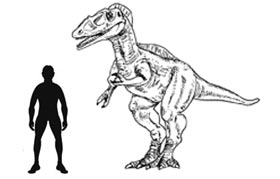Primitive Tyrannosaur from Asia – Alioramus remotus
Known only from a few fragmentary remains, Alioramus (Alioramus remotus) is perhaps one of the more unusual of the Late Cretaceous tyrannosaurs. Palaeontologists have suggested that this dinosaur may have been a particularly fast runner when compared to other tyrannosaurids of the Maastrichtian faunal stage (70-66 million years ago). It might have specialised in hunting other types of prey when compared to the larger and more heavily built Tarbosaurus (T. bataar).
Alioramus remotus
Alioramus (Alioramus remotus), is known from only fragmentary remains, discovered by a joint Soviet/Mongolian expedition to a remote part of Mongolia in the early 1970s. Parts of the skull including the lower jaw and a portion of the upper jaw were discovered along with some toe bones (metatarsals). It is believed that the fossil material represents a sub-adult. The long snout had a series of five small bumps running along it in a line from the nostrils, ending just in front of the large eyes, these were possibly small horns or bony crests. Perhaps this ridge became more prominent as the dinosaur matured. Alioramus may have weighed more than one thousand kilogrammes and perhaps exceeded six metres in length, but since no fossilised remains of a fully grown, mature animal have been found, the size of this particular carnivorous is open to speculation. Alioramus was formally named and scientifically described by Sergei Kurzanov of the Russian Academy of Sciences in 1976.
A Scale Drawing of Alioramus (A. remotus)
Picture credit: Everything Dinosaur
Relatively Long Jaws
This dinosaur had relatively long jaws when compared to the dimensions of its skull. The jaws had more teeth in them than any other known Late Cretaceous tyrannnosaurid. There were eighteen teeth in the front of each lower jaw, many more than found in the front of dentary bones (lower jaw bones) of other tyrannosaurs. The maxilla (upper jaw) had sixteen possibly seventeen teeth.
Recently CollectA, the model and figure manufacturer introduced a model of Alioramus into their not-to-scale dinosaur model range, to view this model and the other replicas available in this series: CollectA Tyrannosaurid Models and Figures.
The first specimen of Alioramus was found in strata known as the Nogoon Tsav Beds of the Ingenii Hoovor valley of Mongolia. A second slightly more complete specimen of Alioramus was found during an expedition to another part of Mongolia (Nemegt Formation). This fossil material also represented a juvenile and for the time being it has been described as a separate species of Alioramus being formally named and described in 2009. However, some scientists speculate that this too could be an example of Alioramus remotus.
Dinosaur fossils, especially those of meat-eaters such as tyrannosaurs are highly prized by practitioners of Chinese medicine who use the teeth in various potions (dragon’s teeth), this and demand for fossils from private collectors has led to a thriving black market in the smuggling of fossils and other artefacts from this part of Asia.







Leave A Comment